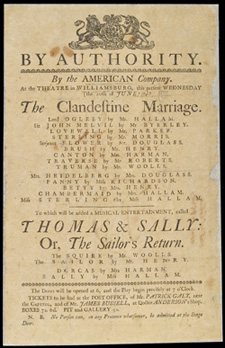Theater

Playbill, Williamsburg (1770)
Theater was an evolving enterprise in the British Colonies in the eighteenth century. In the first half of the eighteenth century, plays were, for the most part, amateur productions. Acting ensembles and student groups performed plays in makeshift theaters, anything from a barn to a large tavern room. However, between 1716 and 1718 the first building specifically designed for use as a theater in British North American was constructed in Williamsburg.
By the middle of the century, the first touring companies of professional actors and actresses from England and Ireland arrived on this side of the Atlantic. These acting companies were itinerant, staying in each location presenting performances for a few days or up to six months. The London Company of Comedians, renamed the American Company in 1763, was the best known troupe of the era and its regular circuit included cities such as New York, Philadelphia, Annapolis, Williamsburg, and Charleston as well as the Caribbean islands of Barbados and Jamaica. The American Company's repertoire was comprised of both well-known plays of William Shakespeare, such as The Merchant of Venice, Richard III and Othello, as well as contemporary pieces like The Beggar’s Opera, The Constant Couple, and The Anatomist, or Sham Doctor.






